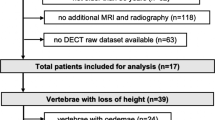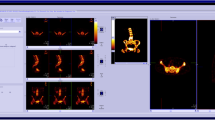Abstract
Objective
To evaluate feasibility and diagnostic performance of multi-level calcium suppression in spectral detector computed tomography (SDCT) for assessment of bone metastasis.
Materials and methods
Retrospective IRB-approved study on 21 patients who underwent SDCT (120 kV, reference mAs 116) and MRI. Thoracic and lumbar vertebrae (n = 357) were included and categorized as normal (n = 133) or metastatic (n = 203) based on MRI (STIR, T1w, ±contrast). The multi-level virtual non-calcium (VNCa) algorithm computes dynamic soft tissue/calcium pairs allowing for computation of different suppression index levels to address inter-individual variance of prevalent calcium composition weights. We computed images with low, medium, and high calcium suppression indices and compared them with conventional images (VNCa_low/med/high and conventional images (CI)). For quantitative image analysis, regions of interest were placed in normal and metastatic bone. Two readers reviewed the datasets independently in multiple sessions. They determined the presence of vertebral metastases on a per vertebra basis using a binary scale. Statistic assessment was performed using ANOVA with Tukey HSD, Student’s T test, and ROC analysis.
Results
Attenuation of both normal and metastatic bone was lower in VNCa images than that in conventional images (e.g., CI/VNCa_low, − 46.3 to 238.8 HU/343.3–60.2 HU; p ≤ 0.05). VNCa_low+med improved separation of normal and metastatic bone in ROC analysis (AUC, CI/VNCa_low/VNCa_med = 0.74/0.95/0.98; p ≤ 0.05). In subjective analysis, both sensitivity and specificity were clearly improved in VNCa_low as compared with CI (0.85/0.84 versus 0.78/0.82). Readers showed a good inter-rater reliability (kappa = 0.65).
Conclusions
Multi-level VNCa reconstructed from SDCT improve quantitative separation of normal and metastatic bone and subjective determination of bone metastases when using low to intermediate calcium suppression indices.
Key Points
• Spectral detector CT allows for multi-level calcium suppression in CT images and low and medium calcium suppression indices improved separation of normal and metastatic bone.
• Thus, multi-level calcium suppression allows to optimize image contrast in regard to dedicated pathologies.
• Low-level virtual non-calcium images (index 25–50) improved diagnostic performance regarding detection of metastasis.





Similar content being viewed by others
Abbreviations
- CI:
-
Conventional images
- CNR:
-
Contrast-to-noise ratio
- DECT:
-
Dual-energy computed tomography
- DSCT:
-
Dual-source computed tomography
- MRI:
-
Magnetic resonance imaging
- PACS:
-
Picture archiving and communication system
- ROC:
-
Receiver operating characteristic
- SBI:
-
Spectral base image
- SDCT:
-
Spectral detector computed tomography
- VNCa:
-
Virtual non-calcium images
References
Hopper KD, Singapuri K, Finkel A (2000) Body CT and oncologic imaging. Radiology 215:27–40. https://doi.org/10.1148/radiology.215.1.r00ap1727
Heindel W, Gübitz R, Vieth V, Weckesser M, Schober O, Schäfers M (2014) The diagnostic imaging of bone metastases. Dtsch Arztebl Int 111:741–747. https://doi.org/10.3238/arztebl.2014.0741
Borggrefe J, Neuhaus V, Le Blanc M et al (2018) Accuracy of iodine density thresholds for the separation of vertebral bone metastases from healthy-appearing trabecular bone in spectral detector computed tomography. Eur Radiol. https://doi.org/10.1007/s00330-018-5843-y
Neuhaus V, Lennartz S, Abdullayev N et al (2018) Bone marrow edema in traumatic vertebral compression fractures: diagnostic accuracy of dual-layer detector CT using calcium suppressed images. Eur J Radiol 105:216–220. https://doi.org/10.1016/j.ejrad.2018.06.009
Kosmala A, Weng AM, Heidemeier A et al (2017) Multiple myeloma and dual-energy CT: diagnostic accuracy of virtual noncalcium technique for detection of bone marrow infiltration of the spine and pelvis. Radiology 0:170281. https://doi.org/10.1148/radiol.2017170281
Petritsch B, Kosmala A, Weng AM et al (2017) Vertebral compression fractures: third-generation dual-energy CT for detection of bone marrow edema at visual and quantitative analyses. Radiology 284:161–168. https://doi.org/10.1148/radiol.2017162165
Zhang LJ, Wang ZJ, Lu L, Chen B, Lu GM (2011) Feasibility of gadolinium-enhanced dual energy CT pulmonary angiography: a pilot study in rabbits. Int J Cardiovasc Imaging 27:1069–1080. https://doi.org/10.1007/s10554-010-9755-4
van Hamersvelt RW, Willemink MJ, de Jong PA et al (2017) Feasibility and accuracy of dual-layer spectral detector computed tomography for quantification of gadolinium: a phantom study. Eur Radiol 27:3677–3686. https://doi.org/10.1007/s00330-017-4737-8
Mei K, Schwaiger BJ, Kopp FK et al (2017) Bone mineral density measurements in vertebral specimens and phantoms using dual-layer spectral computed tomography. Sci Rep 7:17519. https://doi.org/10.1038/s41598-017-17855-4
Dareez NM, Dahlslett KH, Engesland E, Lindland ES (2017) Scaphoid fracture: bone marrow edema detected with dual-energy CT virtual non-calcium images and confirmed with MRI. Skeletal Radiol. https://doi.org/10.1007/s00256-017-2730-6
Zbijewski W, Sisniega A, Stayman JW et al (2015) Dual-energy imaging of bone marrow edema on a dedicated multi-source cone-beam CT system for the extremities. Proc SPIE Int Soc Opt Eng. https://doi.org/10.1117/12.2082304
Wang CK, Tsai JM, Chuang MT, Wang MT, Huang KY, Lin RM (2013) Bone marrow edema in vertebral compression fractures: detection with dual-energy CT. Radiology 269:525–533. https://doi.org/10.1148/radiol.13122577
Reddy T, McLaughlin PD, Mallinson PI et al (2015) Detection of occult, undisplaced hip fractures with a dual-energy CT algorithm targeted to detection of bone marrow edema. Emerg Radiol 22:25–29. https://doi.org/10.1007/s10140-014-1249-6
Hua CH, Shapira N, Merchant TE, Klahr P, Yagil Y (2018) Accuracy of electron density, effective atomic number, and iodine concentration determination with a dual-layer dual-energy computed tomography system. Med Phys. https://doi.org/10.1002/mp.12903
Sudarski S, Apfaltrer P, Nance JW Jr et al (2014) Objective and subjective image quality of liver parenchyma and hepatic metastases with virtual monoenergetic dual-source dual-energy CT reconstructions. An analysis in patients with gastrointestinal stromal tumor. Acad Radiol 21:514–522. https://doi.org/10.1016/j.acra.2014.01.001
Große Hokamp N, Höink AJ, Doerner J et al (2017) Assessment of arterially hyper-enhancing liver lesions using virtual monoenergetic images from spectral detector CT: phantom and patient experience. Abdom Radiol (NY) 43:2066–2074. https://doi.org/10.1007/s00261-017-1411-1
Hanley AJ, McNeil JB (1982) The meaning and use of the area under a receiver operating characteristic (ROC) curve. Radiology 143:29–36. https://doi.org/10.1148/radiology.143.1.7063747
Fleiss JL, Cohen J (1973) The equivalence of weighted kappa and the intraclass correlation coefficient as measures of reliability. Educ Psychol Meas 33:613–619. https://doi.org/10.1177/001316447303300309
Cohen J (1960) A coefficient of agreement for nominal scales. Educ Psychol Meas 20:37–46. https://doi.org/10.1177/001316446002000104
Kottner J, Audige L, Brorson S et al (2011) Guidelines for reporting reliability and agreement studies (GRRAS) were proposed. Int J Nurs Stud 48:661–671. https://doi.org/10.1016/j.ijnurstu.2011.01.016
McCollough CH, Leng S, Yu L, Fletcher JG (2015) Dual- and multi-energy CT: principles, technical approaches, and clinical applications. Radiology 276:637–653. https://doi.org/10.1148/radiol.2015142631
Flohr TG, McCollough CH, Bruder H et al (2006) First performance evaluation of a dual-source CT (DSCT) system. Eur Radiol 16:256–268. https://doi.org/10.1007/s00330-005-2919-2
Shefer E, Altman A, Behling R et al (2013) State of the art of CT detectors and sources: a literature review. Curr Radiol Rep 1:76–91. https://doi.org/10.1007/s40134-012-0006-4
Carmi R, Naveh G, Altman A, Carmi R, Naveh G, Altman A (2005) Material separation with dual-layer CT. IEEE Nucl Sci Symp Conf Rec 4:1876–1878. https://doi.org/10.1109/NSSMIC.2005.1596697
Sellerer T, Noël PB, Patino M et al (2018) Dual-energy CT: a phantom comparison of different platforms for abdominal imaging. Eur Radiol. https://doi.org/10.1007/s00330-017-5238-5
Kelcz F, Joseph PM, Hilal SK (1979) Noise considerations in dual energy CT scanning. Med Phys 6:418–425. https://doi.org/10.1118/1.594520
Kalisz K, Rassouli N, Dhanantwari A, Jordan D, Rajiah P (2018) Noise characteristics of virtual monoenergetic images from a novel detector-based spectral CT scanner. Eur J Radiol 98:118–125. https://doi.org/10.1016/j.ejrad.2017.11.005
Neuhaus V, Große Hokamp N, Abdullayev N et al (2017) Metal artifact reduction by dual-layer computed tomography using virtual monoenergetic images. Eur J Radiol 93:143–148. https://doi.org/10.1016/j.ejrad.2017.05.013
Große Hokamp N, Hellerbach A, Gierich A et al (2018) Reduction of artifacts caused by deep brain stimulating electrodes in cranial computed tomography imaging by means of virtual monoenergetic images, metal artifact reduction algorithms, and their combination. Invest Radiol 53:424–431. https://doi.org/10.1097/RLI.0000000000000460
Große Hokamp N, Salem J, Hesse A et al (2018) Low-dose characterization of kidney stones using spectral detector computed tomography: an ex vivo study. Invest Radiol 53:457–462. https://doi.org/10.1097/RLI.0000000000000468
Pelgrim GJ, van Hamersvelt RW, Willemink MJ et al (2017) Accuracy of iodine quantification using dual energy CT in latest generation dual source and dual layer CT. Eur Radiol 27:3904–3912. https://doi.org/10.1007/s00330-017-4752-9
Yang HL, Liu T, Wang XM, Xu Y, Deng SM (2011) Diagnosis of bone metastases: a meta-analysis comparing18FDG PET, CT, MRI and bone scintigraphy. Eur Radiol 21:2604–2617. https://doi.org/10.1007/s00330-011-2221-4
Ueno M, Aoki T, Murakami S et al (2018) CT temporal subtraction method for detection of sclerotic bone metastasis in the thoracolumbar spine. Eur J Radiol. https://doi.org/10.1016/j.ejrad.2018.07.017
Akasaka T, Yakami M, Nishio M et al (2019) Detection of suspected brain infarctions on CT can be significantly improved with temporal subtraction images. Eur Radiol 29:759–769. https://doi.org/10.1007/s00330-018-5655-0
Kaup M, Wichmann JL, Scholtz JE et al (2016) Dual-energy CT–based display of bone marrow edema in osteoporotic vertebral compression fractures: impact on diagnostic accuracy of radiologists with varying levels of experience in correlation to MR imaging. Radiology 280:510–519. https://doi.org/10.1148/radiol.2016150472
Funding
Part of this study have been funded under a research agreement between (i) University Hospitals Cleveland Medical Center/Case Western Reserve University and Philips Healthcare and (ii) University Hospital Cologne and Philips Healthcare.
Author information
Authors and Affiliations
Corresponding author
Ethics declarations
Guarantor
The scientific guarantor of this publication is PD Dr. med. Jan Borggrefe.
Conflict of interest
The authors of this manuscript declare relationships with the following companies: NGH, DM, JB are on the speakers bureau of Philips Healthcare. ZR, GP are employees of Philips Healthcare.
Statistics and biometry
One of the authors has significant statistical expertise.
Informed consent
Written informed consent was waived by the Institutional Review Board.
Ethical approval
Institutional Review Board approval was obtained.
Methodology
• retrospective
• experimental
• performed at one institution
Additional information
Publisher’s note
Springer Nature remains neutral with regard to jurisdictional claims in published maps and institutional affiliations.
Electronic supplementary material
ESM 1
(PDF 50 kb)
Rights and permissions
About this article
Cite this article
Abdullayev, N., Große Hokamp, N., Lennartz, S. et al. Improvements of diagnostic accuracy and visualization of vertebral metastasis using multi-level virtual non-calcium reconstructions from dual-layer spectral detector computed tomography. Eur Radiol 29, 5941–5949 (2019). https://doi.org/10.1007/s00330-019-06233-5
Received:
Revised:
Accepted:
Published:
Issue Date:
DOI: https://doi.org/10.1007/s00330-019-06233-5




